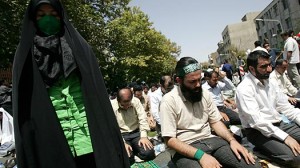By Robin Wright Monday, Jul. 27, 2009

Opposition supporters pray on a street outside Tehran University prior to a protest
SHAIGAN / AFP / Getty
Phase 2 has begun. Six weeks after millions took to the streets to protest Iran’s presidential election, their uprising has morphed into a feistier, more imaginative and potentially enduring campaign.
The second phase plays out in a boycott of goods advertised on state-controlled television. Just try buying a certain brand of dairy product, an Iranian human-rights activist told me, and the person behind you in line is likely to whisper, “Don’t buy that. It’s from an advertiser.” It includes calls to switch on every electric appliance in the house just before the evening TV news to trip up Tehran’s grid. It features quickie “blitz” street demonstrations, lasting just long enough to chant “Death to the dictator!” several times but short enough to evade security forces. It involves identifying paramilitary Basij vigilantes linked to the crackdown and putting marks in green — the opposition color — or pictures of protest victims in front of their homes. It is scribbled antiregime slogans on money. And it is defiant drivers honking horns, flashing headlights and waving V signs at security forces.
The tactics are unorganized, largely leaderless and only just beginning. They spread by e-mail, websites and word of mouth. But their variety and scope indicate that Iran’s uprising is not a passing phenomenon like the student protests of 1999, which were quickly quashed. This time, Iranians are rising above their fears. Although embryonic, today’s public resolve is reminiscent of civil disobedience in colonial India before independence or in the American Deep South in the 1960s.
